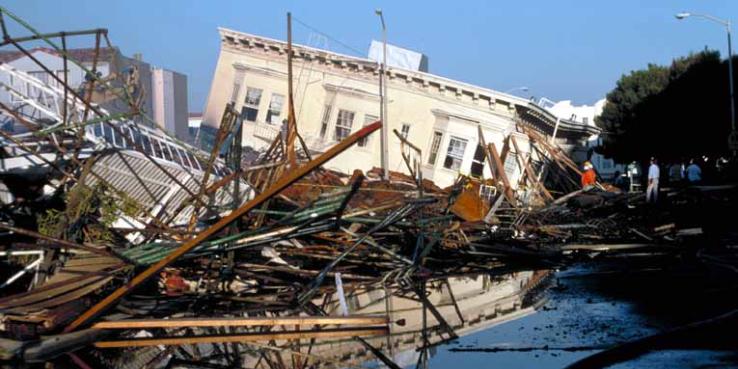This article originally appeared in the San Francisco Chronicle.
The devastating earthquakes that shook Turkey and Syria last Monday have taken the lives of over 23,000 people — a number that is likely to grow as rescue teams are still finding victims amidst the rubble of over 3,500 collapsed buildings.
Such a staggering death toll is hard to wrap the mind around and may seem like an impossibility here in California. Yet, the reality is that a similar magnitude earthquake near Los Angeles or San Francisco could lead to thousands of residents injured or killed and many more displaced, temporarily or permanently, from their damaged or destroyed homes.
In Turkey, many of the collapsed buildings suffered from structural vulnerabilities that are similar to those found in older building types across California — such as “soft-story” apartment buildings or “brittle” concrete buildings. A typical soft-story building is an apartment building of two stories or more located over a ground level that has large openings and few interior walls, such as a parking garage or retail businesses. Although California has begun to retrofit soft-story buildings, this building type is still among the most common and most collapse-prone in the state.
In fact, we’ve already seen these buildings collapse. During the 1994 Northridge earthquake, for example, 16 people perished in the collapse of just one apartment complex that had this type of structure. The U.S. Resiliency Council, a nonprofit dedicated to implementing rating systems that describe the performance of buildings during earthquakes and other natural hazards, estimates that in Southern California alone there are more than 150,000 at-risk soft-story housing units. If we estimate that 2.9 people live in each of these units, the average persons per household in California according to census estimates, there are around 435,000 Californians living in these at-risk buildings just in Southern California.
With California already deep in a housing crisis, what can the state do to address the issue? Require the retrofit homes in areas of high seismic activity.
Retrofitting homes, and in particular affordable housing units, is a cost-effective way to address earthquake safety for California residents. Retrofitting existing affordable housing costs $9,000 and $20,000 per unit (in 2018 dollars), according to research by David Bonowitz, a San Francisco-based structural engineer. That is a far cheaper investment in comparison to building new affordable housing that meets current safety codes, which, in 2016, cost around $425,000 per unit, according to a 2020 report by the UC Berkeley Terner Center. Retrofitting is a commonsense solution that has the potential to save thousands of lives in the event of a major earthquake.
In 2019, after the 7.1 magnitude Ridgecrest earthquake hit Southern California, Gov. Gavin Newsom rallied city and state leaders to get behind improving earthquake safety measures saying, “We all have an opportunity now to get more prepared, to be more vigilant, to look at our building codes, look at home hardening … to be prepared for the next earthquake of magnitude even greater than 7.1.”
In response to the governor’s charge, the U.S. Resiliency Council assembled a diverse coalition of statewide fair housing organizations, apartment owners’ associations, chambers of commerce, environmental organizations, as well as Realtors, cities and building officials to determine the best possible plan for retrofitting the homes of the state’s most vulnerable residents.
Last year, the coalition’s efforts resulted in the unanimous bipartisan passage of SB189, a bill signed by Newsom in June that creates the Seismic Retrofitting Program for Soft Story Multifamily Housing — a program that would provide grants for seismic retrofits to the owners of apartment buildings of two to 20 units. SB189 also appropriated $250 million needed to fund the program over 10 years as part of the state’s budget starting with the 2023-2024 budget cycle.
But last month, the program was omitted from the governor’s draft 2023-2024 budget. While Newsom’s office has not commented on its rationale for the omission, it’s likely that the cut is part of the governor’s goal to solve this year’s budget deficit.
Taking the appropriation out would be a mistake.
Soft-story seismic retrofit ordinances in San Francisco and Los Angeles have encouraged other cities like San Jose and Palo Alto to consider similar programs, but many of them are counting on the new state program to make their efforts viable.
Cutting the state program will bring many of these local efforts to a halt.
The governor can still add the $250 million appropriation back into this year’s budget as the bill he signed into law stipulates. Failing to do so would leave hundreds of thousands of California residents unprotected, and in the event of a massive earthquake, could have fatal implications as well as worsen an already dire housing crisis for years to come.
As the response and recovery efforts in Turkey and Syria continue, please consider donating. It will take years to recover from the devastation. The reality is we can never predict when the next big earthquake will hit. But what the harrowing images from Turkey and Syria make clear, when it comes to preparing California for the next Big One, there is no time to waste.
